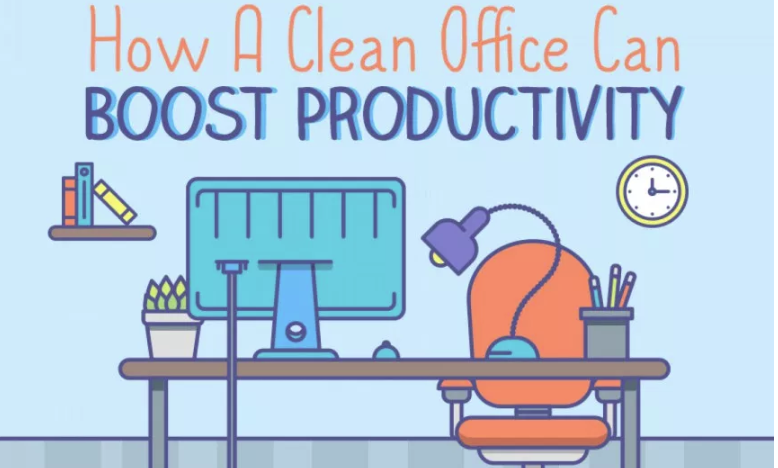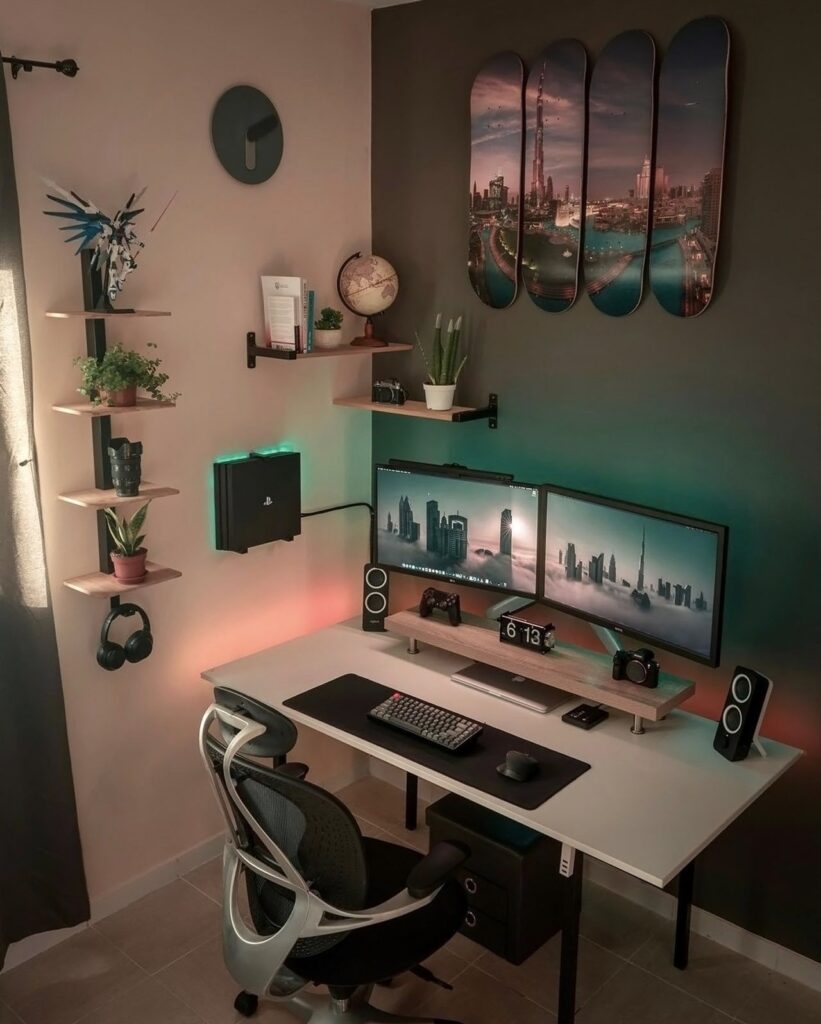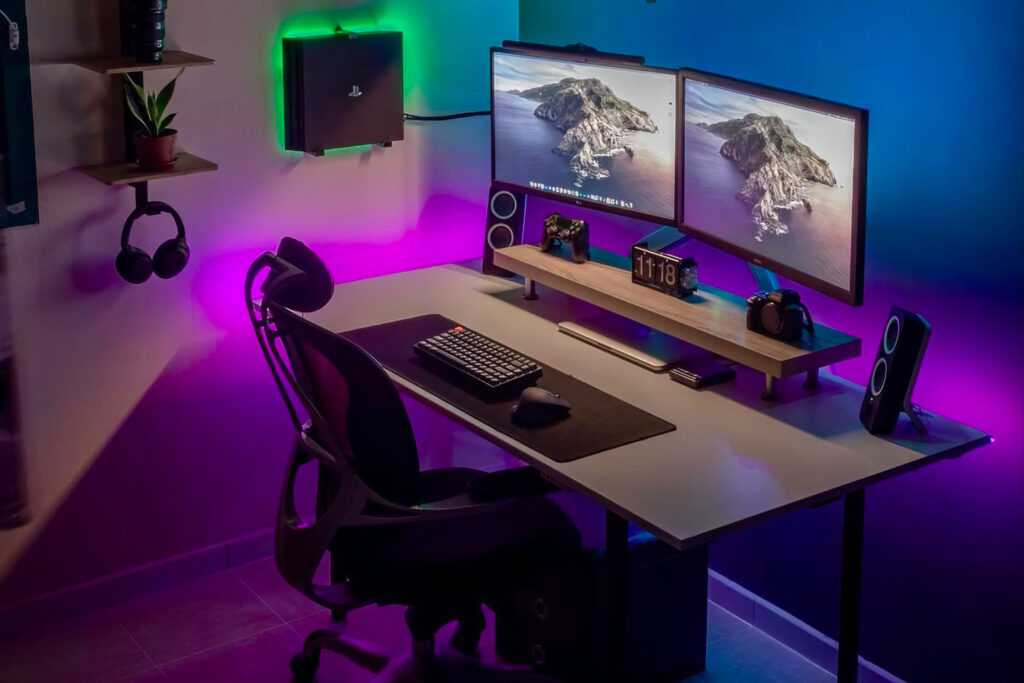Imagine walking into an office that is impeccably clean – not a speck of dust in sight, all surfaces gleaming, and everything organized to perfection. It immediately gives you a sense of order and focus, doesn’t it? Well, that’s exactly what a clean office can do – it has the power to boost productivity and efficiency in the workplace. When your surroundings are tidy and clutter-free, you’re able to think more clearly, stay on track, and complete tasks with ease. In this article, we will explore the various ways in which a clean office can maximize productivity and create a conducive environment for success.

This image is property of 360clean.com.
The Importance of a Clean Office
A clean office is not just about appearances; it has a significant impact on productivity and overall well-being. By reducing clutter and distractions, creating a positive and professional environment, and improving health and well-being, a clean office can help you and your employees work more efficiently and effectively.
Reducing Clutter for Increased Focus
A cluttered workspace can make it difficult to concentrate and stay focused on tasks. When there are piles of papers, scattered office supplies, and miscellaneous items all around you, it can be overwhelming and distracting. By organizing your workspace and clearing clutter, you can create a calmer and more peaceful environment that allows your mind to focus solely on the task at hand.
Creating a Positive and Professional Environment
A clean office not only creates a positive impression on clients and visitors but also boosts employee morale. When employees walk into a clean and well-maintained office each day, it sets a standard of professionalism and shows that their work environment is valued. This can have a profound effect on their motivation, job satisfaction, and overall productivity.
Improving Health and Well-being
An unclean office can harbor germs, allergens, and other harmful substances that can affect the health and well-being of employees. Poor indoor air quality, dusty surfaces, and unsanitary conditions can lead to increased sick days and decreased productivity. By maintaining a clean and healthy office environment, you can help prevent the spread of illnesses, reduce allergies, and promote the overall well-being of everyone in the workplace.
Organizing Your Workspace
A cluttered workspace not only hampers your productivity but also creates unnecessary stress. By implementing effective storage solutions, organizing files and documents, and clearing clutter, you can create a more organized and efficient workspace.
Clearing Clutter and Removing Distractions
Start by decluttering your workspace and removing any items that you no longer need or use. Keep only the essentials within reach and find designated storage spaces for the rest. This will not only create a more organized appearance but also eliminate distractions that can hinder your focus and productivity.
Implementing Effective Storage Solutions
Invest in storage solutions such as filing cabinets, shelves, and bins to keep your office supplies, documents, and personal items neatly organized. Label everything and assign specific places for each item to ensure easy access and efficient workflow. By having a designated place for everything, you can quickly find what you need when you need it, saving valuable time and reducing stress.
Organizing Files and Documents
Maintaining a well-organized filing system is crucial for productivity and efficiency. Sort and categorize your files, both physical and digital, in a way that makes sense to you. Utilize folders, labels, and color-coding to keep everything easily accessible and organized. Regularly review and purge outdated or unnecessary documents to prevent an overwhelming accumulation of paperwork.

This image is property of cleanology.com.
Maintaining a Tidy Work Area
Keeping your work area clean and tidy on a daily basis should be a priority. By implementing a daily cleaning and maintenance routine, practicing good housekeeping habits, and encouraging employees to keep their workspace clean, you can maintain a tidy and organized office environment.
Daily Cleaning and Maintenance Routine
Devote a few minutes each day to clean and organize your workspace. Clear away any coffee cups, food wrappers, or other trash. Wipe down surfaces, sanitize your keyboard and mouse, and vacuum or sweep the floor if necessary. By incorporating these tasks into your daily routine, you can keep your workspace clean and prevent clutter from piling up.
Implementing Good Housekeeping Habits
Good housekeeping habits are essential for maintaining a clean office environment. Encourage employees to clean up after themselves, put away supplies, and keep shared spaces, such as the kitchen and breakroom, clean and organized. By fostering a culture of cleanliness and accountability, you create an environment where everyone takes pride in maintaining a tidy and inviting workspace.
Encouraging Employees to Keep their Workspace Clean
In addition to leading by example, it’s important to educate and encourage employees to keep their own workspaces clean. Provide training on proper cleaning procedures and the importance of maintaining a clean and organized workspace. Consider implementing incentives or rewards for employees who consistently keep their workspace clean and clutter-free. This will not only contribute to a cleaner office but also foster a sense of ownership and pride among employees.
Optimizing Office Layout
The layout of your office has a significant impact on productivity and workflow. By arranging furniture for efficiency, ensuring adequate lighting, and creating zones for different tasks, you can optimize your office layout to promote productivity and enhance the overall work environment.
Arranging Furniture for Efficiency
Consider the flow of movement and accessibility when arranging furniture in your office. Ensure that workstations are set up in a way that allows for easy interaction and collaboration between employees. Position desks and chairs in a manner that minimizes distractions and creates a comfortable working environment. By arranging furniture in a way that promotes efficiency and collaboration, you can streamline workflows and enhance productivity.
Ensuring Adequate Lighting
Proper lighting is essential for productivity and overall well-being. Ensure that your office is well-lit with a combination of natural and artificial light sources. Natural light has been shown to improve mood and alertness, so whenever possible, position workstations near windows. Supplement with task lighting to ensure that every area is adequately illuminated. By providing adequate lighting, you can reduce eye strain, improve focus, and create a more pleasant work environment.
Creating Zones for Different Tasks
Designating specific areas for different tasks can help employees stay organized and focused. Create separate zones for individual work, collaborative work, and break areas. This will not only optimize workflow but also provide employees with a variety of environments suited to different tasks. By creating dedicated zones, employees can easily transition between tasks and adapt their workspace to their specific needs, ultimately increasing productivity.

This image is property of www.pro-sapien.com.
Implementing a Cleaning Schedule
A consistent and structured cleaning schedule ensures that your office remains clean and well-maintained. By hiring professional cleaners, assigning cleaning tasks to employees, and establishing frequency and responsibilities, you can create a comprehensive cleaning plan that meets the needs of your office.
Hiring Professional Cleaners
Consider hiring professional cleaners to ensure thorough and regular cleaning of your office. Professional cleaners have the expertise and tools to efficiently clean and sanitize your workspace. They can handle deep cleaning tasks, such as carpet and upholstery cleaning, and ensure that your office meets industry standards for hygiene and cleanliness.
Assigning Cleaning Tasks to Employees
In addition to professional cleaning services, it’s important to involve employees in the cleaning process. Assign different cleaning tasks to employees on a rotating basis, such as wiping down surfaces, emptying trash bins, and restocking supplies. By involving employees in the cleaning process, you foster a sense of ownership and responsibility for the cleanliness of the office.
Establishing Frequency and Responsibilities
Establish a cleaning schedule that outlines specific cleaning tasks, frequency, and responsibilities. Determine how often each task needs to be completed and assign them to either professional cleaners or employees. Communicate the schedule clearly to everyone in the office so that everyone understands their responsibilities and knows when cleaning tasks are expected to be completed.
Streamlining Digital Organization
In today’s digital age, it’s just as important to have a clean and organized digital workspace as it is to have a clean physical workspace. By organizing your email inbox and folders, utilizing productivity tools and apps, and implementing a digital file management system, you can streamline your digital organization and improve overall productivity.
Organizing Email Inbox and Folders
A cluttered and disorganized email inbox can be overwhelming and hinder productivity. Take the time to declutter your inbox by archiving or deleting unnecessary emails. Create folders and labels to categorize and prioritize emails for easy retrieval. Utilize search and filter functions to find specific emails quickly. By keeping your email inbox organized and clutter-free, you can stay on top of important messages and tasks.
Utilizing Productivity Tools and Apps
There are numerous productivity tools and apps available that can help keep you organized and focused. From task management apps to note-taking tools, find ones that suit your workflow and integrate seamlessly into your daily routine. Use digital calendars and reminder apps to keep track of deadlines and important dates. By utilizing these tools, you can streamline your workflow, prioritize tasks, and increase productivity.
Implementing a Digital File Management System
Just as physical files need to be organized, so do digital files. Implement a structured file management system that categorizes and labels files logically. Create folders and subfolders to group related files together. Utilize naming conventions that are clear and consistent so that files can be easily located. Regularly purge and archive old or unnecessary files to prevent digital clutter. By implementing a digital file management system, you can save time searching for files and ensure that important documents are easily accessible.

This image is property of www.yankodesign.com.
Utilizing Ergonomic Furniture
The comfort and well-being of employees are paramount to productivity. By selecting ergonomic chairs and desks, promoting proper posture and comfort, and providing adjustable equipment, you can create a workspace that supports health and productivity.
Selecting Ergonomic Chairs and Desks
Investing in ergonomic chairs and desks is crucial for the comfort and health of employees. Ergonomic chairs should provide lumbar support, adjustable height, and proper cushioning. Desks should be at a comfortable height and have sufficient space for work tools and equipment. By providing ergonomic furniture, you can reduce the risk of musculoskeletal disorders, such as back pain and repetitive strain injuries, and enhance employee productivity.
Promoting Proper Posture and Comfort
Proper posture is essential for maintaining good health and preventing discomfort. Educate employees about proper sitting and standing positions and encourage them to take regular breaks to stretch and move around. Provide ergonomic accessories, such as footrests and wrist supports, to promote comfort and reduce strain. By promoting proper posture and comfort, you can minimize fatigue and discomfort, allowing employees to focus on their work.
Providing Adjustable Equipment
Not everyone has the same body type or ergonomic needs. Provide adjustable equipment, such as monitor stands, keyboard trays, and adjustable-height desks, to accommodate individual preferences and requirements. Encourage employees to personalize their workstations to best fit their needs. By providing adjustable equipment, you create a more inclusive and accommodating work environment, promoting both comfort and productivity.
Creating a Relaxing Breakroom
The breakroom is where employees go to recharge and rejuvenate. By designing a comfortable and inviting space, promoting healthy eating habits, and incorporating stress-relief activities, you can create a breakroom that truly enhances well-being and productivity.
Designing a Comfortable and Inviting Space
The breakroom should be a space where employees can relax and feel at ease. Choose comfortable seating, preferably with cushioning, and create a welcoming atmosphere with warm colors and natural light. Provide amenities such as coffee machines, microwaves, and refrigerators to facilitate convenience. By designing a comfortable and inviting space, you encourage employees to take regular breaks and recharge, resulting in improved focus and productivity.
Promoting Healthy Eating Habits
Healthy eating habits have a direct impact on energy levels and overall well-being. Encourage employees to make healthier choices by offering nutritious snacks and drinks in the breakroom. Provide a refrigerator and microwave for employees to store and prepare their own meals. Consider organizing healthy eating initiatives or challenges to further promote well-being. By promoting healthy eating habits, you support employee health and vitality, ultimately benefiting productivity in the workplace.
Incorporating Stress-Relief Activities
Breaks are not just about physical rest; they are also an opportunity to relieve stress and recharge mentally. Consider incorporating stress-relief activities in the breakroom, such as puzzles, books, or even a small meditation or yoga area. Provide resources for employees to engage in activities that help them relax and reset their minds. By incorporating stress-relief activities, you create a breakroom that promotes not only physical but also mental well-being, leading to increased productivity.

This image is property of www.yankodesign.com.
Encouraging Personal Responsibility
Maintaining a clean office is a collective effort that requires personal responsibility from every employee. By educating employees on the importance of cleanliness, setting standards and expectations, and rewarding and recognizing cleanliness efforts, you can foster a culture of cleanliness and accountability.
Educating Employees on the Importance of Cleanliness
It’s important for employees to understand the reasons behind keeping the office clean. Share information on the benefits of a clean workspace, such as increased productivity, improved health, and enhanced morale. Provide training on proper cleaning procedures and techniques, as well as the importance of hygiene and sanitation. By educating employees on the importance of cleanliness, you create awareness and a sense of purpose behind maintaining a clean office.
Setting Standards and Expectations
Clearly define cleanliness standards and expectations for the office. Develop a clean office policy that outlines responsibilities, tasks, and consequences for non-compliance. Communicate these standards and expectations to all employees and ensure they are consistently enforced. By setting clear standards and expectations, you establish a framework that guides employees towards maintaining a clean and organized workspace.
Rewarding and Recognizing Cleanliness Efforts
Positive reinforcement goes a long way in encouraging personal responsibility and motivating employees to keep their workspaces clean. Implement a reward system that recognizes individuals or teams who consistently maintain a clean and organized workspace. This can be as simple as acknowledging their efforts publicly or offering small incentives. By rewarding cleanliness efforts, you create a positive and supportive environment that values and encourages personal responsibility.
Implementing Green and Sustainable Practices
A clean office should not only prioritize cleanliness but also environmental sustainability. By reducing paper and energy waste, using environmentally-friendly cleaning products, and encouraging recycling and composting, you can create a clean and sustainable office environment.
Reducing Paper and Energy Waste
Embrace digital alternatives to reduce paper waste and promote efficiency. Encourage employees to go paperless by utilizing online documents and email communication. Set printers and copiers to default to double-sided printing to minimize paper usage. Implement energy-saving practices, such as turning off lights and computers when not in use. By reducing paper and energy waste, you minimize your environmental impact while increasing productivity.
Using Environmentally-Friendly Cleaning Products
Traditional cleaning products often contain harmful chemicals that can be detrimental to both human health and the environment. Switch to environmentally-friendly and non-toxic cleaning products that are free from harsh chemicals. Look for eco-certified or green-labeled cleaning products that meet environmental standards. By using environmentally-friendly cleaning products, you contribute to a healthier and more sustainable office environment.
Encouraging Recycling and Composting
Implement a comprehensive recycling program that includes designated recycling bins for various materials, such as paper, plastic, and metal. Educate employees on proper recycling practices and ensure that recycling bins are prominently placed throughout the office. Consider implementing a composting program for food waste to further reduce waste sent to landfills. By encouraging recycling and composting, you promote sustainability and reduce your office’s environmental footprint.
In conclusion, a clean office is essential for maximizing productivity, fostering a positive work environment, and promoting overall well-being. By organizing your workspace, maintaining a tidy work area, optimizing your office layout, implementing a cleaning schedule, streamlining digital organization, utilizing ergonomic furniture, creating a relaxing breakroom, encouraging personal responsibility, and implementing green and sustainable practices, you can create an office environment that supports success and productivity. So go ahead, make cleanliness a priority in your office, and reap the benefits of a clean and productive workspace.

